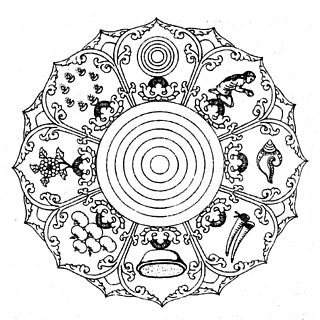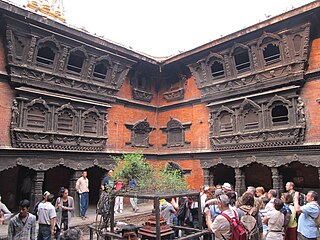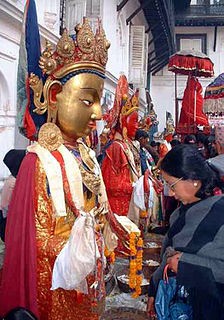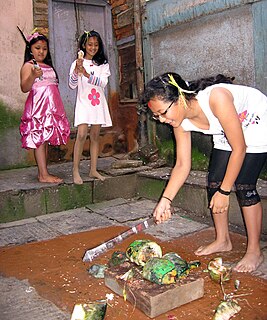Related Research Articles

Diwali is a festival of lights and one of the major festivals celebrated by Hindus, Jains, Sikhs and some Buddhists, notably Newar Buddhists. The festival usually lasts five days and is celebrated during the Hindu lunisolar month Kartika. One of the most popular festivals of Hinduism, Diwali symbolizes the spiritual "victory of light over darkness, good over evil, and knowledge over ignorance". The festival is widely associated with Lakshmi, goddess of prosperity, with many other regional traditions connecting the holiday to Sita and Rama, Vishnu, Krishna, Yama, Yami, Durga, Kali, Hanuman, Ganesha, Kubera, Dhanvantari, or Vishvakarman. Furthermore, it is, in some regions, a celebration of the day Lord Rama returned to his kingdom Ayodhya with his wife Sita and his brother Lakshmana after defeating Ravana in Lanka and serving 14 years of exile.

Bhaktapur / Khwopa, also known as the city of the temples, is a city in the east corner of the Kathmandu Valley in Nepal about 13 kilometres (8.1 mi) from the capital city, Kathmandu. It is located in and serves as the headquarters of Bhaktapur District in Bagmati Pradesh of Nepal. It is administratively divided into 10 wards.

Newar or Nepami, are the historical inhabitants of the Kathmandu Valley and its surrounding areas in Nepal and the creators of its historic heritage and civilisation. Newars form a linguistic and cultural community of primarily Indo-Aryan and Tibeto-Burman ethnicities following Hinduism and Buddhism with Newar language as their common language. Newars have developed a division of labour and a sophisticated urban civilisation not seen elsewhere in the Himalayan foothills. Newars have continued their age-old traditions and practices and pride themselves as the true custodians of the religion, culture and civilisation of Nepal. Newars are known for their contributions to culture, art and literature, trade, agriculture and cuisine. Today, they consistently rank as the most economically, politically and socially advanced community of Nepal, according to the annual Human Development Index published by UNDP. Nepal's 2011 census ranks them as the nation's sixth-largest ethnicity/community, with 1,321,933 Newars throughout the country.
Ranjitkar is one of the castes of Newar. The Newari caste system is divided according to profession. The Ranjitkar caste is concerned with the dyeing of clothes as well as other color related activities. The word "Ranjitkar" comes from Sanskrit origins crudely meaning "people concerned with colors" whereas the word "Chhipaa" is a Nepal Bhasa compound word which can be roughly translated as "color and allow to dry".

The culture of Nepal encompasses the various cultures belonging to the 125 distinct ethnic groups present in Nepal. The culture of Nepal is expressed through music and dance; art and craft; folklore; languages and literature; philosophy and religion; festivals and celebration; foods and drinks.
Dashain, also Bijaya Dashami) is a festival originating from Nepal. In other parts of South Asia, it is called Dashain. Dashain is celebrated by the Hindus of Nepal and the Nepali language speaking people of the Darjeeling hills, Sikkim, Siliguri, Assam and other North-Eastern states of India and among the Lhotshampa of Bhutan and the Burmese Gurkhas of Myanmar. Many people of Nepal celebrate this festival. It is famous in Hindu region.

Nepal Sambat is the lunar calendar used by the people of Nepal. The Calendar era began on 20 October 879 AD, with 1141 in Nepal Sambat corresponding to the year 2020–2021 AD. Nepal Sambat appeared on coins, stone and copper plate inscriptions, royal decrees, chronicles, Hindu and Buddhist manuscripts, legal documents and correspondence. Though Nepal Sambat is declared a national calendar and is used widely in Nepal, it is mostly used by the Newar community whereas Bikram Sambat (B.S) remains the dominant calendar throughout the country. All the major festivals are based on Bikram Sambat along with official purposes.
Thwon is a type of alcoholic beverage. It is prepared on festivals and special occasions by the Newars. It is brewed from rice. This is a kind of Country Beer. Generally it can also be called Rice beer.

Newar Buddhism is the form of Vajrayana Buddhism practiced by the Newar people of the Kathmandu Valley, Nepal. It has developed unique socio-religious elements, which include a non-monastic Buddhist society based on the Newar caste system and patrilineality. The ritual priests (guruju), vajracharya and shakya form the non-celibate religious sangha while other Buddhist Newar castes like the Urāy act as patrons. Uray also patronise Tibetan Vajrayana, Theravadin, and even Japanese clerics.

Newar caste system is the system by which Newārs, the historical inhabitants of Kathmandu Valley, are divided into groups on the basis of Vedic varna model and divided according to their hereditary occupations. First introduced at the time of the Licchavis, the Newar caste system assumed its present shape during the medieval Malla period. The Newar caste structure resembles more closely to North India and Madheshis than that of the Khas 'Parbatiyas' in that all four Varna and untouchables are represented. The social structure of Newars is unique as it is the last remaining example of a pre-Islamic North Indic civilisation in which Buddhist elements enjoy equal status with the Brahmanic elements.
Maharjan, is one of the Hindu Buddhist Newar castes or groups of Nepal, predominantly from Patan, Kirtipur, Bhaktapur and Kathmandu in Kathmandu Valley.. They are a major subgroup of the Jyapu ज्यापू: community inside the Newar community. Maharjan people along with the other subgroups of the same community are also simply known Jyapus.

Mha Pujā is an annual ritual performed by the Newar people of Nepal to purify and empower the soul as part of New Year celebrations. It is performed on New Year's Day of Nepal Sambat, the national lunar calendar of Nepal, which occurs during the Swanti festival.

Ihi, Ehee is a ceremony in the Newar community in Nepal in which pre-adolescent girls are "married" to the Suvarna Kumar which is a symbol of the god Vishnu, ensuring that the girl becomes and remains fertile. It is believed that if the girl's husband dies later in her life, she is not considered a widow because she is married to Vishnu, and so already has a husband that is believed to be still alive.

Newār window refers to the elaborately carved wooden window which is the distinguishing feature of traditional Nepalese architecture. The ornate windows have been described as a symbol of Newar culture and artistry. The level of design and carving of the Newar window reached its peak in the mid-18th century. They are found on palaces, private residences and sacred houses across Nepal Mandala.

Samyak is an almsgiving Buddhist festival celebrated in the Kathmandu Valley in Nepal. During the ceremony which is held on a large open ground, hundreds of images of Dīpankara Buddha are assembled, and gifts of different types of food are made to the deities and the Buddhist community.
Bahra tayegu or bahra chuyegu is a coming of age ritual in Newar community of Nepal in which girls between the ages of 7 to 13 are married to the sun god in a 12-day ceremony. Bahra tayegu is a second marriage of a Newari girl. The first one is ihi- the marriage with the bael fruit. In Nepal Bhasa bahra means a 'cave' and teyegu or chuyegu mean 'to put', thus Bahra tayegu is the ceremony where Newar girls are put in a "cave" for 12 days. For the first 11 days the girl is kept in a dark room away from sun light and any male contact. This is done to purify the girl before her marriage to the sun god on the 12th day. The final day is marked with a bhwe and celebrations.

Mohani or Mohni is one of the most important festivals among the Newars which involves a packed itinerary of religious services, pilgrimages, family gatherings and outdoor celebrations lasting several days. Special dinners known as Nakhtya (नख्त्या), to which all the relatives are invited, continue for weeks later. Mohani is the equivalent of Nepal's biggest festival Dasain, and there are similarities and differences between the two.
The Śreṣṭha or is the second largest Newar caste group, occupying around 25% of overall Newar population, or about 1.2% of Nepal’s total population. It is believed that the word Srēṣṭha is derived from the Newar word Śeśyah, which itself is derivation of a Sanskrit word Sista meaning 'noble', although literal meaning of the word also translated to 'best or important.' "Shrestha" itself was later adopted as the specific family surname by members of this high-caste Hindu group, although there are over 50 other recognized surnames of Srēṣṭhas. Despite their numerically low national population, their high-status and socio-economic capital puts Śreṣṭhas amongst the most privileged and politically over-represented segments of Nepali population.
Alcohol is not illegal in Nepal. The mixed society, coupled with caste and multiple ethnic results in extremely complex social behaviour. Based on the caste and religion, there are two types of people in Nepal depending upon alcohol uses. The group of people who do not drink or use alcohol are called Tagadhari (तगाधारी), and the other group who drink alcohol are called Matawali. Generally, the Brahmins and Kshatriyas are the Janai wearer and do not drink alcohol, but with the exception of Matwali Chhetries of Karnali who are permitted to use alcohol. Matwali uses alcohol for their traditional purposes and generally brew alcohol by themselves. People such as Rai people, Gurung, Tamang, Newars use alcohol freely.
References
- ↑ "Newar - Religion and Expressive Culture". everyculture.com.
- ↑ http://www.lovelypokhara.com.np/contents/show/people_culture/4579.html Archived October 10, 2008, at the Wayback Machine
- ↑ Richard Karl Payne & Kenneth Kazuo Tanaka (2004). Approaching the land of bliss: religious praxis in the cult of Amitābha. books.google.com: University of Hawaii Press. p. 304. ISBN 978-0-8248-2578-2.
- ↑ "Newar Rituals". jwajalapa.com.